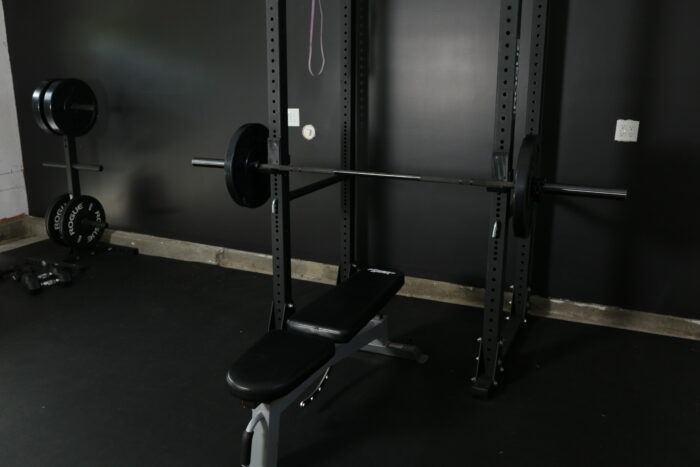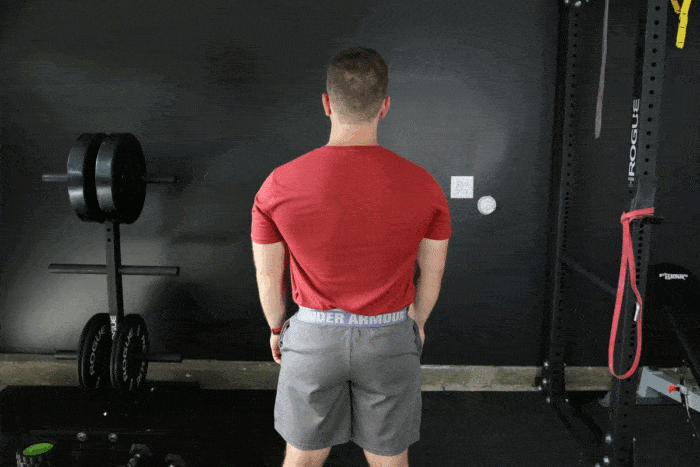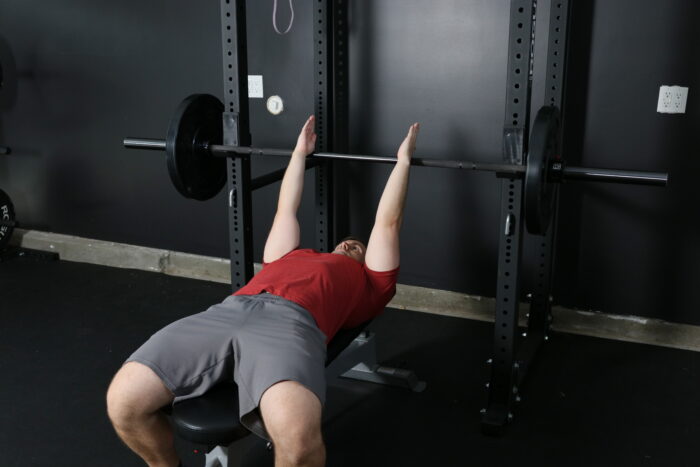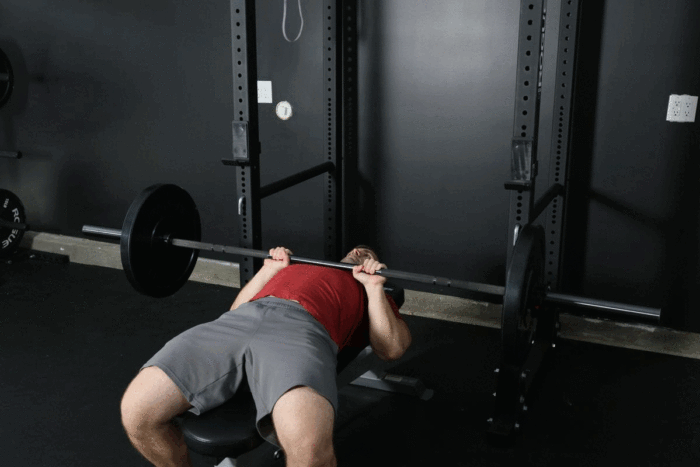Starting off with the close grip bench press can seem intimidating, but it can be amazing at building upper body strength once you get the hang of it.
Some folks steer clear thinking it’s a fast track to an injury, or they just don’t nail the technique and miss out on the major gains.
I’m here to walk you through the ins and outs of mastering this move safely and reaping all its rewards.
In This Article
How To Perform Close Grip Bench Press – Step-By-Step
Below we’ll break down exactly what you need to know so you can master the close-grip bench press and see results without unwanted injury.
Proper Close Grip Bench Press Form
In my experience, the best way to learn any exercise is to learn the fundamental mechanics of the movement.
Below are the key components you’ll need to learn, understand and apply to perform the close grip bench press safely (and effectively).
Step 1 – Bench Position
Before you even touch the barbell, It’s crucial that you set up the bench in the correct position.
The back support of your bench should be flat and parallel to the floor.
Coaching Note: Setup your bench so that it’s parallel to the floor (lying flat at 180°). Make sure when you lie flat on the bench that your eyes are directly underneath the barbell.

Step 2 – Stabilizing Your Shoulder Blades
To stabilize your shoulder blades, follow these steps:
- Squeeze your shoulder blades together and backward
- Roll your shoulders down towards the ground behind you
- Imagine holding a pencil between your shoulder blades to maintain the tension.

This helps keep the focus of the exercise on your triceps and chest muscles instead of your shoulders.
Coaching Note: With your hands at the appropriate grip length, imagine you’re trying to squeeze a pencil between your shoulder blades and hold it in place.
Step 3 – Grip Width
During a close grip bench press, there is no benefit to having a grip width more narrow than shoulder width. So, your grip width should only be roughly the width of your shoulders. Start by placing your arms at shoulder width against the bar. Note where your arms naturally rest at this point.
Next, using your index fingers first, grab the bar and ensure both hands are equidistant from each other.
Coaching Note: A good rule of thumb is to take a grip that is roughly equal to shoulder width when your elbows are tucked by your torso.

Step 4 – Elbow Position
Bring your elbows as close to your torso as you can comfortably get them while keeping your shoulders flat against the bench.
Coaching Note: Your elbows should be tucked by your torso throughout the movement. The position of your elbows should feel natural to you while pressing – not exaggerated.

Step 5 – Breathing, Bracing & Executing the Exercise
It’s time to prepare and stabilize your core, so you perform the exercise. Take a deep breath, inhaling to create internal pressure that wraps around your abdominal muscles. Finally, you can unrack the barbell and perform the close grip bench press at a controlled tempo (and with confidence).
Coaching Note: When you are breathing and bracing your core correctly, you should feel your ribs (not your stomach) expand laterally on both sides, creating internal pressure.
Close Grip Bench Press Benefits
- Stronger Triceps: Tighter grip and elbow positions increase triceps tension, leading to strength gains. Make sure you’re implementing a form of progressive overload to see the best results.
- Less Shoulder Strain: Keeps shoulders in a safer position, reducing injury risk. This is especially true compared to wider grips, which can strain shoulders.
- Boosts Inner Chest: Maximizes chest muscle tension for better growth, placing the chest muscles in a position of maximum tension and load. Think incline bench press vs. close grip bench press.
Don’t forget about recovery. A key to recovery isn’t just stretching; it’s also about deep muscle work, especially for those of us with tight schedules and tighter shoulders.
That’s where my massage gun has become a lifesaver. It works wonders on soreness and keeps me feeling loose and ready!
Theragun Massage Gun
TheraGun Prime is a core part of my recovery routine. With its deep muscle treatment, I can train harder and recover faster. It's simple to use and surprisingly quiet which is ideal for easing tightness anytime, anywhere.
Watch this in-depth review to make so you can decide for yourself!
Close Grip Bench Press Muscles Worked & Their Roles
Below is a short breakdown of the close grip bench press muscles worked and the different roles each plays.
Agonist Muscles
These are the muscles doing the brunt of the work contracting to generate movement for the exercise.
- Triceps Brachii
- Pectoralis Major (Sternum)
Synergist Muscles
The synergist muscles are a group of nearby muscles that assist the prime movers (agonists) in executing an exercise. They do this by helping stabilize the joint around where movement is happening.
- Deltoid, Anterior (Clavicle)
Antagonist Muscles
The antagonist’s muscles perform the opposite action of the prime mover. (ex: If your bicep (bicep curl prime mover) is actively contracting and shortening then your tricep is relaxing and lengthening.)
- Biceps Brachii
- Latissimus Dorsi
- Deltoid, Posterior
Bottom Line: The close grip bench press exercise places most of the emphasis on your triceps and chest muscles with reduced involvement from your shoulders. Your delts are utilized less because of the positioning of your elbows & arms which are tucked closer to your core during this exercise.
Frequently Asked Questions About Close Grip Bench Press
Here are some of the most common questions we’ve compiled and answered for you.
What Does Close Grip Bench Press Work?
The close-grip bench press targets your triceps and chest, with the secondary engagement of your shoulders.
Is Close Grip Better for Bench Press?
A close grip bench press is great for building arm strength and reducing shoulder strain, as it targets the triceps and chest with less emphasis on the shoulders.
Is Wide Grip or Close Grip Bench Easier?
The effectiveness of wide-grip and close-grip bench presses varies depending on your body type, strength, and preference. Experiment to find what works best for you.
Unlock the Benefits of Close Grip Bench Press!
The close grip bench press is a solid compound lift that can help build muscle across your triceps and chest.
If you’re looking to build bigger, stronger arms, this is a great option to help you accomplish that.
Want more workout tips for increasing upper body strength & size? Read this to learn how to do pull-ups and build a stronger back.


